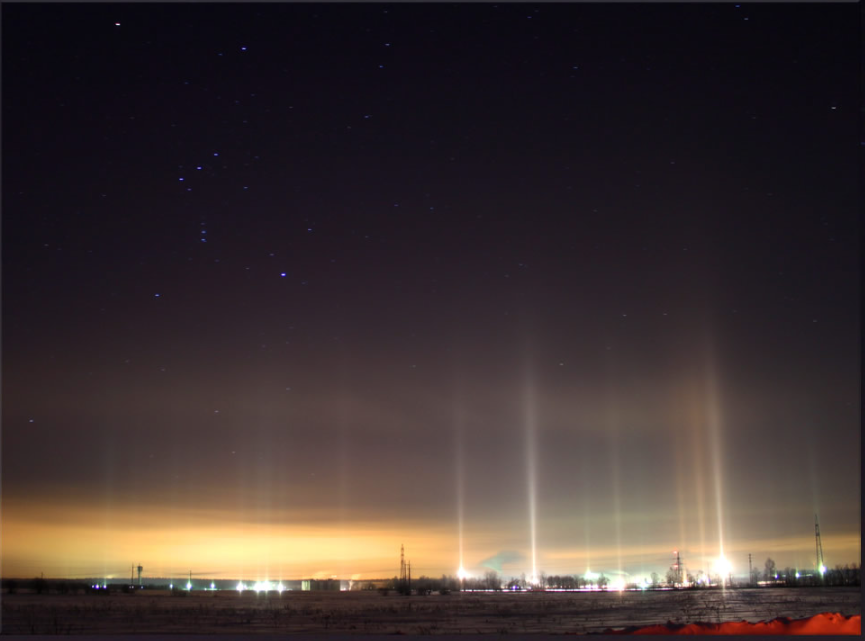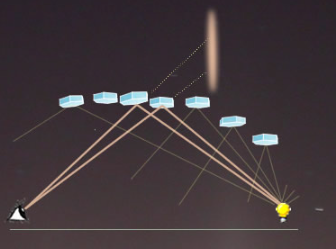OPOD - Illusionary Pillars
Illusionary Pillars in the Sky: A Fascinating Atmospheric Phenomenon
Have you ever looked up at the night sky and been captivated by the sight of pillars seemingly beaming upwards? These enchanting illusions, known as light pillars, can create a mystical atmosphere that leaves us in awe. In this article, we will delve into the intriguing world of illusionary pillars and explore the science behind their formation.
The Astonishing Discovery by Anton Yudin
One particularly striking observation of illusionary pillars was made by Anton Yudin on January 26th, 2011, near St. Petersburg, Russia. Despite the freezing temperature of -22°C, Yudin managed to capture a breathtaking image of these pillars using his Canon EOS 500D camera with an 18-55mm lens. The long exposure of 46 seconds added a touch of ethereal beauty to the photograph, with the stars appearing slightly trailed. This mesmerizing image offers a glimpse into the captivating nature of illusionary pillars.
The Illusion Unveiled: Reflections and Ice Crystals
Although these pillars appear tangible, they are merely illusions and do not exist in physical form. The phenomenon arises from the reflection of artificial lights by countless ice crystals suspended in the atmosphere, located roughly halfway between the light source and the observer's camera.
Typically, these reflecting ice crystals take the shape of hexagonal plates that drift through the intensely cold air. Their large horizontal faces act as mirrors, reflecting light back downwards. When certain crystals align in such a way that they direct their reflected light towards the viewer, they collectively create an illusionary pillar shape in the sky.
The Role of Hexagonal Ice Crystals
Hexagonal ice crystals play a pivotal role in the formation of light pillars. As they tumble through the air, these crystals rotate and present various orientations to the observer. Consequently, they create an ever-changing array of pillar shapes and sizes. The intricate interplay between the orientation of the ice crystals and the angle of observation contributes to the captivating and dynamic nature of illusionary pillars.
Notable Characteristics of Illusionary Pillars
Now that we understand the basics of how illusionary pillars are formed, let's explore some notable characteristics of this atmospheric phenomenon:
-
Colorful Displays: Light pillars often exhibit vibrant hues, including reds, oranges, yellows, and blues. These colors arise from the dispersion and scattering of light as it interacts with the ice crystals.
-
Light Source Dependence: The appearance of light pillars is directly dependent on the presence of artificial light sources, such as streetlights or car headlights. Without these sources, the illusionary pillars would not manifest.
-
Temperature Influence: Illusionary pillars are more likely to occur during extremely cold weather conditions when ice crystals are abundant in the air. The frigid temperatures facilitate the formation of these remarkable optical illusions.
The Wonders of Atmospheric Optics
The realm of atmospheric optics never fails to astound us with its array of captivating phenomena. From shimmering rainbows to mysterious halos, each optical phenomenon offers a unique glimpse into the beauty and complexity of our atmosphere. Illusionary pillars, with their enchanting display of light and ice crystals, add yet another fascinating chapter to this captivating field of study.
As we continue to explore and understand the science behind these natural wonders, we can develop a deeper appreciation for the intricate workings of our world. So, next time you find yourself gazing at the night sky and witnessing the spellbinding sight of illusionary pillars, take a moment to marvel at the remarkable interplay between light, ice, and our atmosphere.

Orion & Light Pillars
Anton Yudin saw these pillars giving the illusion of beaming upwards at his location of 30 km from St. Petersburg, Russia on 26th January '11. The temperature was -22C.
He used a Canon EOS 500D 18-55 lens at 18mm/3.5, ISO 100. The exposure of 46s caused the stars to trail slightly. ©Anton Yudin, shown with permission.

The pillars are an illusion. They do not exist.
Their appearance is produced by reflection of the artificial lights by millions of ice crystals roughly half way between the lights and the camera.
The reflecting crystals are usually, but not always, hexagonal plates drifting in the intensely cold air. Their large hexagonal faces are more or less horizontal. Each acts as a mirror, reflecting light back downwards. Those that happen to glint their light towards the viewer collectively give an apparent pillar shape in the sky.

Note: this article has been automatically converted from the old site and may not appear as intended. You can find the original article here.
Reference Atmospheric Optics
If you use any of the definitions, information, or data presented on Atmospheric Optics, please copy the link or reference below to properly credit us as the reference source. Thank you!
-
<a href="https://atoptics.co.uk/blog/opod-illusionary-pillars/">OPOD - Illusionary Pillars</a>
-
"OPOD - Illusionary Pillars". Atmospheric Optics. Accessed on November 26, 2024. https://atoptics.co.uk/blog/opod-illusionary-pillars/.
-
"OPOD - Illusionary Pillars". Atmospheric Optics, https://atoptics.co.uk/blog/opod-illusionary-pillars/. Accessed 26 November, 2024
-
OPOD - Illusionary Pillars. Atmospheric Optics. Retrieved from https://atoptics.co.uk/blog/opod-illusionary-pillars/.